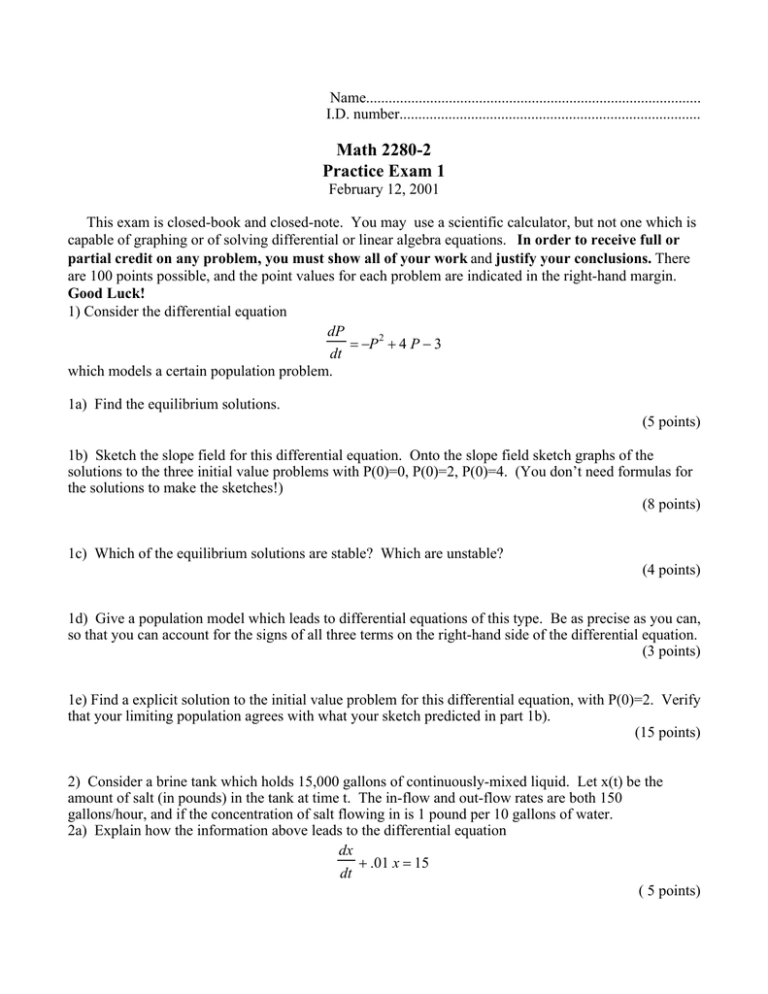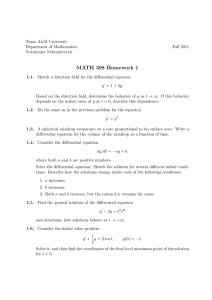Name......................................................................................... I.D. number................................................................................
advertisement

Name......................................................................................... I.D. number................................................................................ Math 2280-2 Practice Exam 1 February 12, 2001 This exam is closed-book and closed-note. You may use a scientific calculator, but not one which is capable of graphing or of solving differential or linear algebra equations. In order to receive full or partial credit on any problem, you must show all of your work and justify your conclusions. There are 100 points possible, and the point values for each problem are indicated in the right-hand margin. Good Luck! 1) Consider the differential equation dP 2 = −P + 4 P − 3 dt which models a certain population problem. 1a) Find the equilibrium solutions. (5 points) 1b) Sketch the slope field for this differential equation. Onto the slope field sketch graphs of the solutions to the three initial value problems with P(0)=0, P(0)=2, P(0)=4. (You don’t need formulas for the solutions to make the sketches!) (8 points) 1c) Which of the equilibrium solutions are stable? Which are unstable? (4 points) 1d) Give a population model which leads to differential equations of this type. Be as precise as you can, so that you can account for the signs of all three terms on the right-hand side of the differential equation. (3 points) 1e) Find a explicit solution to the initial value problem for this differential equation, with P(0)=2. Verify that your limiting population agrees with what your sketch predicted in part 1b). (15 points) 2) Consider a brine tank which holds 15,000 gallons of continuously-mixed liquid. Let x(t) be the amount of salt (in pounds) in the tank at time t. The in-flow and out-flow rates are both 150 gallons/hour, and if the concentration of salt flowing in is 1 pound per 10 gallons of water. 2a) Explain how the information above leads to the differential equation dx + .01 x = 15 dt ( 5 points) 2b) Solve the initial value problem for this differential equation, assuming that at time t=0 there is no salt in the water. You may use either chapter 1 or chapter 3 techniques. (10 points) 2c) What is the limiting amount of salt as t approaches infinity? (5 points) 3a) Consider the differential equation d2 x dx +5x=0 2 dt dt Find the general solution to this differential equation. If this was modeling a spring problem, what kind of damping would we have? (15 points) +4 3b) Solve the initial value problem for the differential equation above, for x(0)=2, Dx(0)=-2. (10 points) 3c) Write your solution to 3b) in the form of a time-varying amplitude times cos(wt-a). (10 points) 4) We know that any expression A cos(ω t ) + B sin(ω t ) Can be rewritten as C cos(ω t − α ) And you probably memorized the formulas for this exam. 4a) Use the addition angle formula for cosine to rederive the formulas for C and alpha in terms of A and B. (5 points) 4b) Find C and alpha so that 1 sin(t ) + 2 cos(t ) − 2 cos t + π = C cos(t − α ) 4 (5 points) 5) (Well, I ran out of points, but here’s another problem): 5a) Solve d3 x 3 + 2 d2 x 2 dt dt With initial condition x(0)=1, Dx(0)=1, D^2(x)(0)=0. + dx =0 dt (15 points) 5b) Find an implicit solution to (2 x + 3 y ) dx + (3 x + 2 e y ) dy = 0 (10 points)



